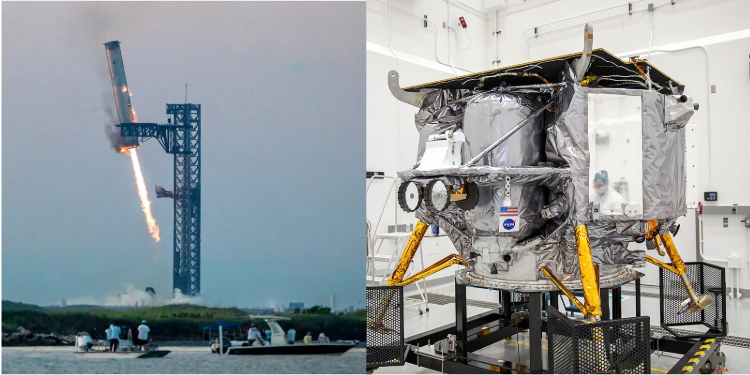Photo caption – “SpaceX’s massive Starship rocket booster was successfully caught by the launch tower’s mechanical arms (left). The Peregrine Lander ahead of launch, with the nano Iris Lunar Rover bolted to its exterior (right). (Source: Sergio Flores/AFP via Getty Images and Wikipedia)”
By James Brown, New York – As space exploration becomes more affordable, the economic landscape of the industry is experiencing unprecedented growth. Recent milestones, such as SpaceX’s breakthrough catch of the huge Starship booster, highlight how engineering innovations are making reusable, low-cost missions a reality. The development and launch of the Iris lunar rover—led by a renowned team of experts at Carnegie Mellon University (CMU)—has set a new benchmark for low-cost space missions. Priced at just under $1 million, the Iris rover mission has opened doors for venture capitalists, private equity firms, and startups eager to enter the rapidly expanding space sector. The World Economic Forum projects the sector will reach $1.8 trillion by 2035. However, while cost-efficiency is key, securing space missions is now emerging as an equally critical focus, ensuring the safety of mission-critical data and sustaining long-term operational success.
The Iris rover mission exemplifies how economical space missions are reshaping the industry. Traditionally, launching payloads has required tens of millions of dollars, limiting access to governments and large corporations. The Iris team, however, was able to design a cost-effective mission by leveraging materials like carbon fiber to reduce weight, which in turn contributed to lowered launch costs.
At the same time, SpaceX’s recent success in catching its 19-storey Super Heavy rocket with ‘chopstick’ arms during its fifth test flight demonstrates the industry’s relentless pursuit of affordability and reusability. By making booster recovery faster and more efficient, SpaceX is driving down operational costs and setting the stage for more frequent launches. These advancements are part of a larger trend, enabling both private enterprises and research institutions like Carnegie Mellon University to undertake ambitious missions that were previously beyond their reach.
“Our mission was to be ultra low cost, and carbon fiber being a strong material which could withstand all of the conditions … that was one of our reasons to make it of carbon fiber,” said Harshvardhan Chunawala, Mission Operator of Iris Rover, in an interview with Forbes. “It takes off weight which ultimately reduces the overall cost of the launch.”
The Iris rover wasn’t just about cutting costs—it was a collaborative effort built on decades of expertise at Carnegie Mellon. Faculty Emeritus William ‘Red’ Whittaker, a space exploration pioneer, mentored the team and shaped the project’s vision from its inception. “It has been half a century since CMU boots walked the moon, and it is great to be heading back with our first robot,” said Whittaker. “In space, what counts is what flies. Our missions, tech, and people live by that value. By every measure, Carnegie Mellon University is a space-faring university.”
The affordability of the Iris rover has broad implications for the space industry, making missions financially accessible to universities, startups, and emerging markets. As costs decrease, opportunities for venture capitalists and private equity firms are expanding, particularly as space-based projects become less capital-intensive. This is setting the stage for the next phase of space commercialization, with secured cloud computing playing a crucial role in keeping these missions secure and scalable as more players enter the market.
As space systems grow increasingly reliant on interconnected technologies, cybersecurity is an immediate challenge. According to a recent case study by Cutter, the growing dependence on interconnected systems in space exploration introduces heightened risks, from cyber espionage and sabotage to threats against life support and navigation systems. The ramifications of a security breach are severe—ranging from data loss to the endangerment of human life.
In response to emerging cyber threats, Harshvardhan Chunawala, Mission Operator for the Iris Rover Mission and a cloud computing security expert, developed practicum – hands-on technical training for securing space missions at CMU. In an interview, he remarked: “Organizations may soon begin leveraging satellite constellation projects complemented by existing ground stations and hardened cloud infrastructure for future space missions.” His work focuses on building secure cloud-based solutions to address gaps in critical systems, such as space missions, and to drive modernization. By integrating real-time encryption, proactive threat detection, secure data routing, and advanced monitoring on satellite networks, cloud security initiatives enhance the protection of mission-critical data, addressing several risks identified in studies like Cutter’s.
By integrating cloud solutions, organizations can secure their missions while achieving cost savings through scalable cloud infrastructure resources that use predefined security configurations deployed by Infrastructure as a Code (IaaC) templates. This approach allows mission operators to reallocate resources to other critical functions while maintaining a robust security posture that is scalable. As the space industry continues to evolve, the ability to rapidly address threats and minimize downtime will be key for the success of future missions. Such initiatives ensure that as space becomes more accessible, it remains secure—an essential factor as nations and private enterprises ramp up their space exploration with cloud computing.
The convergence of cost-efficient missions and secure cloud computing is driving the emergence of new business models in the space industry. As costs drop and cloud-based solutions become more accessible, space-as-a-service is accelerating at a remarkable pace. Companies are now exploring innovative ways to monetize space-based services, including satellite leasing and real-time data analytics powered by secure cloud infrastructure. For investors, low-cost missions present a burgeoning sector with growth potential. As cyberthreats are expected to increase, cybersecurity will be crucial for ensuring the long-term success of any venture including space. With private investment and government initiatives accelerating, organizations prioritizing information security will play a vital role in keeping space missions resilient and sustainable.
Sources for this article include reports from the World Economic Forum, the Cutter case study on cybersecurity challenges in space, Carnegie Mellon University’s INI practicum; the Iris Rover mission information from CMU News, and a New York Times article on SpaceX’s Starship booster catch.




















